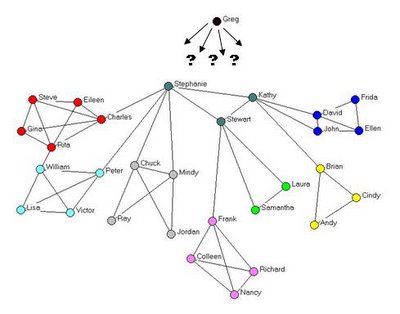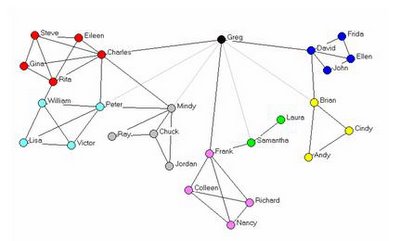"Despite the acknowledgment that leaders spend most of their time interacting with others, the social capital of leaders is perhaps the most ignored, under-researched aspect of leadership."They go on to explain the critical role of social capital in their article "The Social Capital of Twenty-First-Century Leaders" (which is the ninth chapter of Elsevier's Out of the Box Leadership):
"In contrast to human capital (traits and behaviors), social capital refers to relationships with other actors, and the accompanying access to information, resources, opportunities, and control. Because organizational leadership involves accomplishing work through others, it is critical that we assess the social capital of leaders."What does the social capital of leaders tell us? Brass and Krackhardt summarize the state of the art with two broad strategies: "strong tie" and "weak tie."
Connecting to Central Others--The Strong Tie Strategy
Strong ties refer to close, trusting relationships. To motivate the strong tie strategy, consider which connections will most help Greg to lead ABC Associates, pictured below. Each link represents the regular sharing of work-related information:
 With the additional insight that Stephanie, Stewart, and Kathy each manage separate sub-teams within the above organization, it becomes clear that Greg should establish strong ties to these three central figures.
With the additional insight that Stephanie, Stewart, and Kathy each manage separate sub-teams within the above organization, it becomes clear that Greg should establish strong ties to these three central figures. The strong tie strategy helps Greg support a cohesive team with just a few direct relationships. Notice that it also makes Greg completely dependent on Stephanie, Stewart, and Kathy. This may not be a problem, since Greg is able to build loyal and trusting relationships with each of these highly connected others. However, this loyalty comes with a price: Greg's tight-knit team of managers will be relatively impervious to outside ideas and highly susceptible to group-think.
The strong tie strategy helps Greg support a cohesive team with just a few direct relationships. Notice that it also makes Greg completely dependent on Stephanie, Stewart, and Kathy. This may not be a problem, since Greg is able to build loyal and trusting relationships with each of these highly connected others. However, this loyalty comes with a price: Greg's tight-knit team of managers will be relatively impervious to outside ideas and highly susceptible to group-think.Connecting Others Who Are Not Connected--The Weak Tie Strategy
Suppose that ABC Associates flattens its organizational hierarchy by eliminating middle managers and increasing collaboration among their former direct reports. At such a re-engineered ABC Associates, Greg faces a more complex terrain of relationships where the strong tie strategy breaks down:
 With responsibility for such a dispersed team, Greg can no longer establish his leadership with just a few loyal lieutenants. Instead, Greg must rely also on weak ties, which refer to acquaintances and other distant colleagues.
With responsibility for such a dispersed team, Greg can no longer establish his leadership with just a few loyal lieutenants. Instead, Greg must rely also on weak ties, which refer to acquaintances and other distant colleagues. In the example above, Greg connects to each of his seven work groups with a strategic combination of strong ties (dark edges) and weak ties (light edges). With his weak tie strategy, Greg wins influence over the organization through his unique access to a wide variety of novel resources and information. As long as he can continue to maintain relationships with such a diverse group of contacts, Greg is in an ideal position to promote innovation within his organization.
In the example above, Greg connects to each of his seven work groups with a strategic combination of strong ties (dark edges) and weak ties (light edges). With his weak tie strategy, Greg wins influence over the organization through his unique access to a wide variety of novel resources and information. As long as he can continue to maintain relationships with such a diverse group of contacts, Greg is in an ideal position to promote innovation within his organization.Choosing Between the Strong Tie and Weak Tie Strategies
Brass and Krackhardt devote the second half of their paper to contingencies that influence the relative effectiveness of the strong tie and weak tie strategies. Briefly, these include
- Surrounding network structure: densely connected groups support a strong tie strategy, while sparsely connected or dispersed groups support a weak tie strategy.
- Career stage: a strong connection to a powerful mentor helps early in one's career but limits growth opportunities later.
- Boundaries to entry: those who struggle to enter established networks (such as women, minorities, or new managers) can overcome these barriers with a strong tie strategy; otherwise, a weak tie strategy generally leads to faster promotions.
Implications for training and research
More on that soon.
[Thanks to Tiziana Casciaro for bringing this article to my attention.]
This work is licensed under a Creative Commons Attribution-ShareAlike 2.5 License and is copyrighted (c) 2006 by Connective Associates except where otherwise noted.


1 comment:
Every relationship is governed by the circumstances people are in....and at work, the circumstances are different from 'real life'...read this article 'why your boss is programmed to be a dictator' (www.changethis.com)...it looks at circumstances at work from a system's perspective, and the need for relationships to be examined from that viewpoint.
Post a Comment